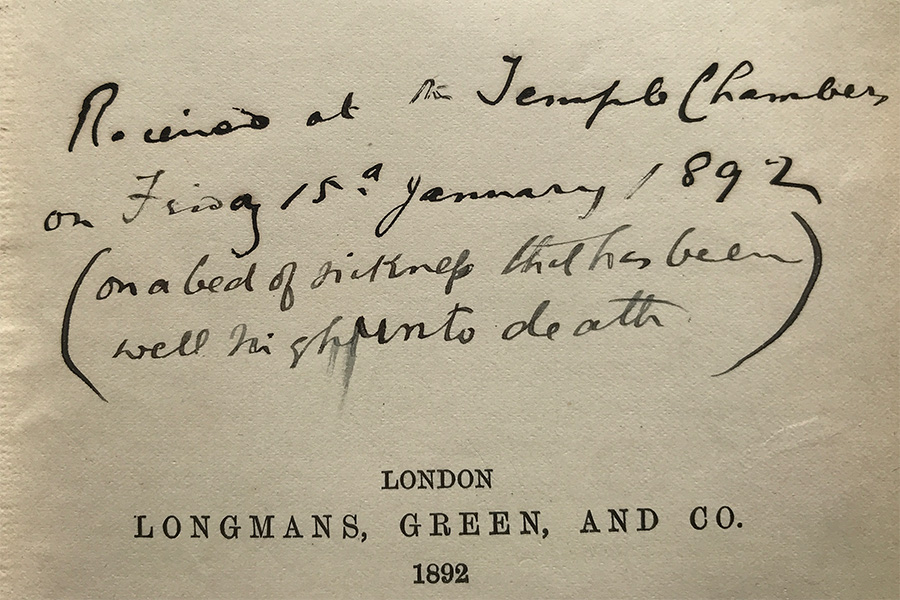The case of the morbid book inscription
In December 2013, while visiting one of my favourite second-hand book shops with a friend, I came across a first edition of the essay collection New Fragments by one of Charles Darwin’s close friends, the physicist John Tyndall.
I was still working on my book On the Moor: Science, History and Nature on a Country Walk at the time. John Tyndall features prominently in two chapters, so I felt compelled to buy the book. (Well, that was my excuse, and I’m sticking to it.) Perhaps more intriguing than the book itself was the dramatic, hand-written inscription on the title page:
Transcript: Received at [the?] Temple Chambers on Friday 15th January 1892 (on a bed of sickness that has been well nigh unto death)
I concluded the inevitable blog post about my find with the confident prediction, ‘I guess I’ll never know the story behind these words—which is one of the appeals of such enigmatic inscriptions.’
But, hang on! Not so fast, Richard…
Mystery solved?
Four years and three days after coming across the enigmatic inscription, I happened to end up in a Twitter exchange with none other than the ghost of John Tyndall. (Twitter is weird like that.) I took the opportunity to draw his attention to my find:
HOLY CRAP!!
True to his word, the ghost of John Tyndall did indeed get back to me the next day, in the guise of his amanuensis and biographer, Roland Jackson, who wrote:
[T]here’s an outside chance that your book is inscribed by [the mathematician] Thomas [Archer] Hirst. 15 January was publication day and he might have risen from his sickbed to get a copy. He died on 16 February. Tyndall at the time was confined to Hindhead, and the writing isn’t his wife’s (who might have gone to get it but I think there’s no mention in the diary) or his I think.
I attach the only really contemporary letter of Hirst’s we have. His writing seems to have changed quite a bit as he got more and more ill. There are resemblances but I’m not sure strong enough to be definitive. See what you think, making allowances for a sick man scrawling it on his bed.
Here is the attached letter from Hirst:

Reproduced by courtesy of the Royal Institution of Great Britain.
SOURCE: RI MS JT/1/H/480
Transcript:
4 Jany 1892
My dear John
I have just ordered your dozen of Whisky It ought to reach you tomorrow, or next day, I trust you will continue to like it, at your midday repast.
What do you think of Sir W. Thomson’s new Peerage? People here are wondering what title he will select to bear.
As to your possible change from Hind Head; Spencer has just been saying that he found perfect quiet at Bournemouth. This is worth knowing; for he is almost as sensitive as you are, with respect to quietude at night.
Every yours affectionately | Tom
A letter concerning whisky, containing gossip about the future Lord Kelvin, and with word from (presumably) Herbert Spencer: right up my street!
I’m no handwriting expert, but, as Roland Jackson suggested, I compared my book inscription with the Hirst letter and noticed a number of similarities, namely:
- the year 1892, which appears in both samples, looks very similar (especially, the elongated, lowered numeral 9, and the curly flourish at the top of the numeral 2);
- the lower-case ‘m’ in the word ‘midday’, and the (presumably) upper-case ‘M’ in ‘My’ in the letter both have very distinctive curly opening finials. These closely resemble the curly opening finial on the letter ‘n’ in the word ‘nigh’ in the book inscription;
- (less convincingly) the upper-case ‘T’s in ‘Thomson’ and ‘Tom’ in the letter are similar in style to the upper-case ‘T’ in ‘Temple’ in the book inscription.

Two other factors to consider:
- Thomas Archer Hirst kept an extensive scientific-diary-cum-everyday-book for 47 years. Although the diary does not mention receiving Tyndall’s New Fragments, its final entry was dated 18th January 1892—just three days after the date of the book inscription. This would tie in very well with Hirst’s being ‘well nigh unto death’. (He died as a result of a major influenza epidemic less than a month later, at his home in Marylebone, London, on 16 February 1892.)
- Whoever wrote the inscription in my book was sufficiently interested in the writing of John Tyndall to take delivery of his latest book from their sickbed on the very day it was published. Hirst, being a very close friend of Tyndall, and a voracious science-reader would seem to fit that bill very nicely.
Do I think this conclusively proves my morbid book inscription was indeed written by Tyndall’s dear friend Thomas Archer Hirst? No I don’t. But do I strongly suspect it was? You betcha!
Pleasing co-incidences
I couldn’t let the opportunity occasioned by writing about Thomas Archer Hirst and John Tyndall go by without relating a couple of personally interesting co-incidences about their friendship.
While I was researching Tyndall for my book, I learnt that he and Hirst first became friends as young men while surveying a proposed railway line between Halifax and Keighley, West Yorkshire. Those towns both lie just 20 minutes’ drive from my home. More pleasing, however, was it to discover that the man they both worked for was my namesake, the land agent and surveyor Richard Carter.
Shameless plug
Read more about John Tyndall (and Charles Darwin, Robert FitzRoy, Sir Thomas Browne, Celtic languages, evolution’s kludgy compromises, wheatears, triangulation, Ted Hughes, Sylvia Plath, grouse disease, defining species, DNA barcoding, the Laws of Thermodynamics, the Brontës, snipe courtship, skeletons, rooks, the Greenhouse Effect, blue skies, the songs of skylarks, contrails, and much more) in my book On the Moor: Science, History and Nature on a Country Walk.

